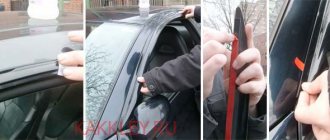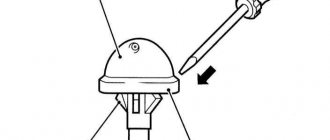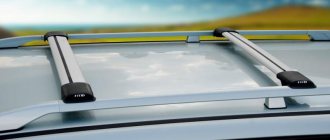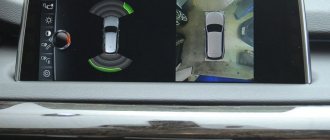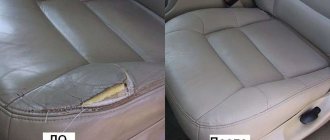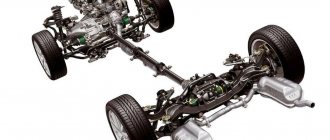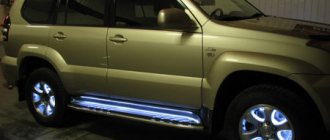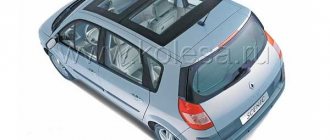Car deflectors, also known as wind deflectors, may or may not be liked visually, but there is no point in denying their benefits. Some drivers believe that such “tuning” spoils the appearance of the car, but it can definitely save a lot of nerves, money and time for the car owner. Deflectors are inexpensive, and their installation takes no more than 20 minutes. At the same time, in any service, specialists will require a lot of money to install wind deflectors. In this article, we will look at how to install deflectors yourself, as well as purchase wind deflectors.
Why are deflectors needed on a car?
The main function of deflectors, naturally, is not aesthetic, and they are installed for protective purposes and the desire to preserve the integrity of the car’s glass, as well as its paint. Wind deflectors are most often installed on the car doors, and in some cases on the hood. The presence of deflectors allows you to:
It is worth noting: If the car has a sunroof, sometimes deflectors are installed near it. They not only provide protective functions, but also help reduce the noise level in the car.
The design of the deflectors is designed in such a way that when the machine moves, they create a dense air flow that removes dirt, small stones, rain particles and various debris. In this case, the deflectors are installed in a high-pressure zone, and it is necessary to secure them well during installation so that they do not come off during the trip.
How to glue side window deflectors to a car
Almost all models of windshields are produced already equipped with an adhesive strip. This turns the process of gluing elements into a 10-minute task. The main condition is to be careful and attach the parts exactly the first time. Otherwise they will lie crooked, so you will have to tear them off and re-glue them.
If the fairings you purchased are not equipped with an adhesive layer, purchase special adhesive tape from the auto store. Before work, it is heated with a hair dryer. The main advantage of this adhesive material is ease of use. You don’t have to drill anything or use additional fasteners; your car doors will remain without a single scratch.
In order to beautifully glue deflectors on car doors, you need dry, warm weather of at least +15°C. Place everything you need for work next to the machine:
- construction hair dryer;
- set of wind deflectors;
- adhesive tape, preferably SA-Plastik, AutoAx, SIM;
- dry rags;
- technical solvent.
Prepare the surface of the side windows:
- Wash your car, carefully going over the areas you will be working on.
- Wipe the fastening points of the windshields with solvent.
- If the body panel has previously been polished using wax or paraffin mastics, clean the areas where the fairings are glued more thoroughly.
Types of deflectors for car doors
You can find various windshields on sale, which differ in their shape, cost, manufacturer, the presence of additional accessories included, color and many other parameters. At the same time, the main criterion by which you should choose deflectors is the way they are installed on the car. The following types of windshields can be found on sale:
- Plug-in
. These models are easier to install, but they perform worse in use. Wind deflectors are installed between the glass and the rubber seal, which is why they can cause inconvenience when opening/closing the glass on some car models; - Invoices
. This type of deflector is attached to the door frame and will take a little longer to install. Also, the installation of such windshields is somewhat more complicated, but if installed correctly, they will last longer and will not interfere with the car glass.
When buying windshields in a store, you need to choose models that are suitable specifically for your car. It is better to give preference to deflector options from well-known manufacturers. In most cases, such models are equipped with consumables that will be required to install the product.
How to choose car window deflectors correctly?
Of course, you need to consider options that are made specifically for your car model. This information is required on the packaging. It is often duplicated using embossing on the plastic parts themselves.
And there cannot be universal models, because each brand of car has a body to which these elements are attached very tightly. Don’t forget that the doors can be decorated with chrome elements, so the tuning needs to be selected to imitate this metal, so that the overall appearance of the car is preserved in the original style that the designer intended.
How to install deflectors on windows
Depending on whether plug-in or surface-mounted deflectors are used, you need to know the features of their installation, as well as how the process of installing the accessory itself occurs.
Important:
When installing deflectors, do not forget to monitor visibility from the car. They must be mounted so that they do not block the view of the road.
How to install plug-in deflectors
Plug-in deflectors are attached under the door frame - in the groove where the glass fits when lifted. To install them, you need:
After installing the wind deflector, make sure that the glass closes smoothly and that the installation of the deflector does not affect the operation of the lifts.
It should be noted that plug-in deflectors can fall off at any time, and drivers don’t particularly like them for this. The fact is that at high or low temperatures the adhesive base loses its properties when connected to the groove.
How to install overhead deflectors
Installing overhead deflectors is a little more difficult and requires some tools. However, when installed correctly, surface-mounted deflectors will last much longer than plug-in deflectors, and they do not have any effect on the operation of the window regulator, also eliminating the risk of scratches on the glass due to wind deflectors.
Having beautiful windshields is the desire of many car enthusiasts, and the reason for this is not only the popularity of Hollywood films that glorify the beauty of speed and the aesthetics of sports cars like the Fast and the Furious series. But not everyone welcomes such “tuning” - you can often hear how it can spoil the appearance with its obsessive provocative design.
Nevertheless, installing deflectors helps the motorist avoid many problems, in the long run allowing him to save peace of mind, time and money - indeed, their installation will not take more than an hour. It should be noted that all this will be relevant only if you install the deflectors yourself - alas, this service is very popular in car repair shops, and therefore the price may turn out to be quite “evil”.
However, as was said earlier, their installation is not a labor-intensive process, does not require much time and is quite feasible even for inexperienced motorists. Further, the article will reveal the main reasons why you should think about purchasing and installing deflectors, their types, various installation locations in addition to the hood, some features of the installation itself, and draw conclusions containing some reasoning on this topic and summing up everything written below.
A deflector, popularly nicknamed a “fly swatter,” is a special lining on a car, the main function of which is to protect against many small stones, insects, dust and other objects flying into the car at high speed. Most often, they are made of high-strength acrylic glass or plastic.
This is what a car deflector looks like
Probably the very first reason for installing deflectors on a car is the pursuit of style. They catch the eye and catch the eye of passers-by, of course girls! A tuning kit, also from a well-known brand, cannot help but transform the exterior of your car.
The deflector is made in an aerodynamic design, which allows you to create upward air currents when driving, which allows you to rid the windshield, hood and windshield wipers from the possibility of contamination. But most importantly, it absorbs impacts from flying large objects, deflecting them away from the windshield, which can significantly reduce the likelihood of cracks appearing on the windshield.
The principle of operation of the deflector
You can often hear complaints from motorists in which the importance of deflectors is greatly depreciated - indeed, at low speeds its work is practically unnoticeable. Only when driving at speeds above 70-80 km/h. an air flow of that force may arise that can “push out” the stones with the required force.
The Internet is full of not only negative reviews about the performance of these pads. Some motorists claim that the deflectors are capable of creating such strong air currents that they can cope not only with insects and dust, but even with the volumes of fine gravel and dirt that fly out of trucks rushing nearby at high speeds.
Car with deflector on the hood
The front part of the hood, the false radiator grille and the bumper are the most vulnerable to damage from sand, gravel and various living creatures that were not lucky enough to break on the fragile paintwork during the trip.
Deflectors can be installed not only on the hood, but also on doors, windows and even car mirrors. Installing door visors will eliminate the problem of rain getting into the cabin, this is especially true when dealing with foggy windows - no matter how heavy the rain, thanks to the visors you can leave a good gap for air, and all the water will flow down.
Deflectors on car windows
Those who like to smoke in cars will also find door deflectors useful. After their installation, air flows will flow at a distance from the windows and doors of the car, due to which all the smoke will go outside.
In many ways, the result of installing a “fly swatter” will depend on the model of deflector that the car enthusiast purchases. When choosing, it is important to remember that deflectors are a fairly specific device, even highly specialized, and are intended for one specific make and model of car. If you buy a trim that is not designed specifically for your existing car, then it may simply not “stand up” or very quickly fly off from the slightest collision with the same pebbles or sand.
Various types and shapes of hood deflectors
When choosing a deflector, first of all you should consider not the quality of the plastic “fly swatter”, or even the type of fastening - you should be interested in the installation instructions, their clarity and correctness. Novice motorists should familiarize themselves with it before purchasing, which in many ways, if the information in it is clear and redundant, should predetermine the choice of the deflector and its seller.
Example instructions for installing a deflector on a car hood
As soon as the motorist understands the samples on the market, during the final purchase the question will arise about choosing a deflector with the best type of fastening. At the moment, the following types of fasteners are common on the component market:
- Bolt mounting through special holes;
- Gluing with flexible rubber bands;
- Installation using bracket-clips;
- Installation in default mounting holes.
When considering these options, you should immediately discard the first two options - these are simply killers of the paintwork on the hood
. Moreover, with subsequent removal of the deflector for one reason or another, traces in the form of holes and scraps of glue and rubber bands will remain on the surface of the hood. Removing traces of glue is very difficult, almost impossible without damaging the paintwork, not to mention the holes. Thus, it is worth paying attention only to the last two methods from the above list.
Before writing anything about installing a “fly swatter”, we note that most motorists recommend installing it in accordance with the existing instructions.
This may seem surprising, but among the people, one of the most common ways to install deflectors is to glue it with double-sided tape. On the one hand, this method is the simplest, on the other hand, the cheapness does not allow us to talk about quality and any reliability. However, if the deflector is attached to a special tape, it is necessary to increase the number of places where this tape is fixed. To make sure that you don’t have to look for the “fly swatter” on the road on a dark night somewhere in the forest, you need to make four or five areas of fixation with this tape.
Installing a deflector with double-sided tape is one of the worst installation options
Some modern foreign cars may already have a deflector installed in one form or another. Cars with this configuration are already equipped with special fastenings included in the constitution of the car by its manufacturer. The presence of such can be found out from the description of the car, if information about “European fasteners” is found. Some motorists deliberately look for models with a similar configuration, since the presence of the provided “fly swatter” eliminates any further action.
Original deflector for Toyota Hilux Exclusive
Another method, which is one of the simplest and safest for the car’s paintwork, is to install a deflector with special bracket-clips. This type of fastening involves installing the deflector on the edge of the hood lid using a kind of clothespins. On the inside, these clips are equipped with soft gaskets, which makes it possible to avoid damage to the paint on the hood. The process of installing such a windshield is quite simple, does not require serious effort and goes through a number of sequential steps:
- The surface of the car hood is thoroughly washed and dried.
- Having prepared the surface of the hood, the “fly swatter” is removed from the packaging, after which it is tried on at the place of intended installation.
- Having unpacked the deflector and its fastenings, the mounting brackets are secured to it, after which the fitting is repeated and marks are made on the hood at the intended installation location.
- In some assemblies, the deflector comes with small transparent covers that resemble adhesive tape. Their number usually coincides with the number of deflector holes. They need to be glued under the places on the hood where the clips will be put on. This is done to ensure that they do not scratch the hood.
- The next step is to remove the fasteners from the deflector, after which they are installed on the edge of the hood.
- Having installed the fasteners on the edge of the hood, the deflector is taken and placed on the hood body in accordance with the marks made earlier, after which the entire structure is fixed with supporting parts on the plane.
- Finally, using mounting screws, if the cover design allows this, the brackets are attached to the inner frame of the hood.
Despite the simplicity of the above method of installing a “fly swatter”, many manufacturers, trying to be leaders in the race for simplicity and practicality, have introduced types of deflectors that are completely devoid of mounting brackets. Needless to say, this type of parts does not require any knowledge of “automotive engineering” at all, and can be installed even by a child.
Such deflectors are widely used among new foreign cars, but if you look, you can find analogues for a used car. The “new” “fly swatters” are distinguished by the presence of three curved petals at the front, the gaps in which ideally overlap the gaps of the elastic seal retainer on the front edge of the hood. The installation process of such a part looks even simpler:
- Having opened the hood, the plastic fasteners are unfastened and removed, the location being exactly like those of those “fly swatter” petals.
- Fixing components are mounted into the existing “eyes”.
- The overlay is placed on the protruding parts of the fixing elements, after which everything is turned over with bolts (if necessary).
- Using holes in the ellipse-shaped plates, it is possible to adjust the position of the deflector relative to the center line of the hood to obtain better aerodynamic qualities.
- Fixing the remaining screws.
The easiest way to install a deflector on the hood
Step-by-step installation of deflectors on windows
Self-adhesive products
- Attach and secure with mounting tape the cutoffs above the front and rear side windows.
- Shine it inside with a flashlight to check the correct position.
- Mark the location of the edge with construction tape or another convenient method.
- Remove the visor, degrease the marked surface above the door with a professional primer, alcohol or the cloth provided.
- Peel off and bend outward the protective tape from all edges by 2-3 cm and attach the deflector to the door, according to the markers.
- Holding the windshield in the desired position with one hand, pull out the entire protective tape by the tip with the other and press the product to the surface.
- Walk along the edge with a rag, pressing and ironing the edge with force.
- Warm up the joint with a hair dryer and iron again.
Installation of plug-in deflectors
- Lower the window.
- Insert the edge of the windshield into the upper groove intended for the glass entrance.
- The deflectors are attached to the rear door with double tape.
Since the bumper in the front door is held in place by elasticity, when the contour of the edge does not coincide with the groove, it should be slightly bent.
For a visual example, watch the video
You should not buy cheap products with poorly sharpened edges. They prevent the glass from entering the groove and destroy its protective film.
However, even high-quality plug-in windshields are not suitable for all car models. For some brands, the deflector is installed only using an adhesive base.
The principle of operation of the deflector
Ventilation deflectors are installed on the pipes to prevent wind from blowing into the exhaust shaft. For clarity, you can imagine a simple office split system. Surely everyone has seen that condensing devices are equipped with special screens for protection. This is somewhat reminiscent of the principle of operation of a deflector.
A large number of types of these products are being developed, but they all operate on the same principle. The air is directed into a diffuser - a cap above the deflector, and hits the sides of the product. The flow flows around the entire structure without passing into it. The treated air is then removed from the pipe without any obstacles.
Materials
The product has been used for a long time and has been modernized many times to this day. New models are developed from time to time. In the manufacture of exhaust ventilation deflectors, plastic or galvanized steel is used. Metal products can last much longer. It is better to give preference to these deflectors rather than plastic ones.
As mentioned earlier, these products are used not only to protect hoods, but also to protect chimneys. Each home owner has the opportunity to significantly increase draft and protect their fireplace or stove from overturning air flows by installing ventilation deflectors. In such cases, plain galvanized steel is not suitable. You need to use special boiler metal. This is a fairly durable and expensive material that can withstand much higher temperatures without burning out. If the flow cools down before leaving the chimney, you can safely install a ventilation deflector made of galvanized metal. Therefore, it is recommended to first make a calculation of the possible heating of the smoke coming out through the pipe.
why are they needed, how to choose and install - Auto-Self.ru
Car deflectors, also known as wind deflectors, may or may not be liked visually, but there is no point in denying their benefits. Some drivers believe that such “tuning” spoils the appearance of the car, but it can definitely save a lot of nerves, money and time for the car owner. Deflectors are inexpensive, and their installation takes no more than 20 minutes. At the same time, in any service, specialists will require a lot of money to install wind deflectors. In this article, we will look at how to install deflectors yourself, as well as purchase wind deflectors.
Why are deflectors needed on a car?
The main function of deflectors, naturally, is not aesthetic, and they are installed for protective purposes and the desire to preserve the integrity of the car’s glass, as well as its paint. Wind deflectors are most often installed on the car doors, and in some cases on the hood. The presence of deflectors allows you to:
- Protect the paintwork of the machine from small stones, insects, dust and other dirt. All debris flies away from the deflectors or settles on them. When windshields are installed on doors, they also help protect the glass from small parts that could cause it to crack;
- Prevent rain from entering the interior. Their installation is especially important for drivers whose interior windows often fog up, which can be removed by opening the window. In the rain, the deflectors will allow you to open the window just enough so that fresh air enters the cabin and drops of water flow past;
- Change the air flow path. By installing a deflector, the air flow while the car is moving passes a little further from the door and window of the car. Wind deflectors are an ideal solution for smokers who know very well that when driving, all the smoke from a cigarette ends up in the cabin, but installing deflectors solves this problem.
It is worth noting: If the car has a sunroof, sometimes deflectors are installed near it. They not only provide protective functions, but also help reduce the noise level in the car.
The design of the deflectors is designed in such a way that when the machine moves, they create a dense air flow that removes dirt, small stones, rain particles and various debris. In this case, the deflectors are installed in a high-pressure zone, and it is necessary to secure them well during installation so that they do not come off during the trip.
Types of deflectors for car doors
You can find various windshields on sale, which differ in their shape, cost, manufacturer, the presence of additional accessories included, color and many other parameters. At the same time, the main criterion by which you should choose deflectors is the way they are installed on the car. The following types of windshields can be found on sale:
- Plug-in . These models are easier to install, but they perform worse in use. Wind deflectors are installed between the glass and the rubber seal, which is why they can cause inconvenience when opening/closing the glass on some car models;
- Invoices . This type of deflector is attached to the door frame and will take a little longer to install. Also, the installation of such windshields is somewhat more complicated, but if installed correctly, they will last longer and will not interfere with the car glass.
When buying windshields in a store, you need to choose models that are suitable specifically for your car. It is better to give preference to deflector options from well-known manufacturers. In most cases, such models are equipped with consumables that will be required to install the product.
How to install deflectors on windows
Depending on whether plug-in or surface-mounted deflectors are used, you need to know the features of their installation, as well as how the process of installing the accessory itself occurs.
Important: When installing deflectors, do not forget to monitor visibility from the car. They must be mounted so that they do not block the view of the road.
How to install plug-in deflectors
Plug-in deflectors are attached under the door frame - in the groove where the glass fits when lifted.
To install them, you need:
- Lower the window;
- Insert the windshield, slightly bending it according to the shape of the door, if installed on the front door of the car. It is worth noting that on the front door the deflector is held in place largely due to this bend, while on the rear door it is held mainly by a gluing element;
- Make sure that the deflector has a sufficiently ground part that fits into the groove. If this is not the case, then the car window will not close completely and, moreover, will constantly scratch against the deflector. It is necessary that the glass does not touch the deflector when raising and lowering or does so minimally;
- Having tried on the windshield, you need to secure it. If there is adhesive tape on it, then use it. In the option where it is missing, you will have to use your own double-sided tape. Also, some deflectors have special rivets for fastening.
After installing the wind deflector, make sure that the glass closes smoothly and that the installation of the deflector does not affect the operation of the lifts.
It should be noted that plug-in deflectors can fall off at any time, and drivers don’t particularly like them for this. The fact is that at high or low temperatures the adhesive base loses its properties when connected to the groove.
How to install overhead deflectors
Installing overhead deflectors is a little more difficult and requires some tools. However, when installed correctly, surface-mounted deflectors will last much longer than plug-in deflectors, and they do not have any effect on the operation of the window regulator, also eliminating the risk of scratches on the glass due to wind deflectors.
To install overhead deflectors, you must:
- Clean the car well, and most importantly the places where the deflectors will be attached;
- When the car is washed, wipe dry again with a lint-free cloth (you should also not use a sponge) where the deflectors are installed;
- Degrease the places where the windshields are installed. It is best to use ethyl alcohol or regular vodka for this. To degrease, wipe the surface with alcohol applied to paper napkins, not sponges, for maximum effect;
- Next you need to choose a place to mount the deflector. To do this, attach it and roughly figure out how it should be positioned so that it does not block the view from the cabin and performs the functions assigned to it. Some drivers prefer to install deflectors in the lower or upper corner, others limit themselves to the middle option. Determine the optimal mounting location for yourself and make small marks on the car body with chalk or a pencil to make it easier to navigate where to attach the part during installation;
- After this, the protective film is removed from the tape, and the deflector is installed in the marked place. Experts and experienced drivers recommend doing one of the following before gluing the windshield:
- Warm up the adhesive tape and the attachment point a little with a hairdryer. The slightly melted adhesive base of the deflector will attach better to a warm surface, and it will hang longer;
- Add extra stickiness to the tape using quick-release adhesive. You need to apply a little Moment glue or something similar to the adhesive surface. In this case, it is better not to apply glue over the entire surface, otherwise later there will be difficulties with cleaning it if the deflector needs to be replaced. Apply a few peas of glue every 5 centimeters.
After installing the deflector, you need to give some time for the adhesive base to dry. It is better not to use the car for at least 3 hours, and you will have to refrain from washing it for 3-4 days.
( 425 votes, average: 4.56 out of 5)
Share with friends on social networks:
Telegram
What are the different types of deflectors for ventilation systems?
Not only external, but also internal deflectors are often used. They are designed to disperse fresh flows and prevent drafts. In this way, the air masses are distributed more evenly throughout the room in which the split system or inlet is installed. The exhaust air is forced out faster, and the room's visitors are not blown through. Before choosing a deflector for a ventilation system, it is necessary to consider the available range of models that differ in type of design, which include TsAGI devices, the Shenard model, Volper, the open Astato deflector, the Grigorovich sample, and a spherical rotating device.
How are ventilation deflectors created?
What's the point of paying money for a finished device if you can purchase all the necessary materials and assemble the deflector yourself. The tools you will need are a tape measure, a welding machine, galvanized steel, metal scissors, an angle grinder and a drill, nuts, bolts, clamps, and a set of keys. You can recreate almost all existing deflector designs with your own hands. The simplest option for self-production would be the Grigorovich model without complex mechanisms and connections.
First you need to make a drawing, then cut out the cardboard model in full size, transfer the dimensions to the steel and cut out the blank parts. To assemble the model, welding machines and other additional connecting elements are most often used. The bracket for the deflector can be cut from strips of metal. The cap is secured using cut out fragments, and a cone is installed on top. The creation of such a device makes it possible to increase the efficiency of the ventilation system by 15-20%, as well as protect against debris and moisture getting inside the pipe.
How it works
This device works very simply. It is based on the phenomenon of reflection of air flow from the diffusion plane. When the air flow meets this very diffuser, Bernoulli’s law immediately begins to operate, that is, the air is cut, a rarefied area appears, which increases the level of thrust.
Often many people mistakenly perceive ventilation deflectors only as devices necessary for poor draft. In fact, they are recommended even where everything is fine with the ventilation system. The thing is that this device is capable of increasing the efficiency level of the ventilation system to 20% of the existing one.
Why do you need to install car window deflectors?
This seemingly small and simple car tuning part actually performs many useful and very important functions, such as;
- good protection for the inside of your car from the bright sun;
- creating an air flow, which, in turn, carries away debris and dust, and even small pebbles;
- the ability to drive with the windows partially open for natural ventilation of the cabin even in wet weather without the risk of getting the cabin and passengers wet;
— the air flows that are created by these parts make it possible to ventilate the interior much more efficiently, which is especially important when passengers are traveling with a smoking driver, and installing this type of tuning on the windows is an excellent compromise for everyone if it so happens that the driver is dependent on.
Varieties
Today you can find a huge variety of different deflectors on the construction markets. They all differ from each other in appearance, purpose and materials of manufacture.
It must be said right away that deflectors can be not only ventilation, but also others. For example, such devices are widely used in the aircraft industry, as well as in the automotive industry.
As already mentioned, motorists will tell you exactly what a hood deflector is, for example. They all know very well what door deflectors are, or as they are also called “wind deflectors”. It must be said that the “wind vent” can only be made of plastic, but similar devices for chimneys and ventilation systems are made of metals:
- Aluminum;
- Stainless steel;
- Cink Steel;
- Very rare, but copper products are also found.
So, if everything is clear with the scope of application, then with the design it’s not so much. On this basis, all such devices are divided into:
- Tsaga deflectors;
- Open disc type;
- Round;
- Star;
- A device operating on the Grigorovich principle;
- H-shaped products.
The simplest and most popular is the Grigorovich deflector.
Among other things, two more large classes can be distinguished. The deflector can be:
- Rotary or rotating;
- Static, that is, motionless.
It’s worth saying a little about the technical characteristics of such devices. There aren't many of them. You can only highlight the dimensions and material of manufacture. When choosing, attention should be paid, first of all, to the principle of construction, that is, the design of the product, and only then select the desired size from the desired type.
What type of window deflector installation is best to choose?
Many drivers like to open the side windows a little while driving. This is done for better ventilation or if the driver smokes. If you also don’t like driving in a completely closed car, then you need to consider purchasing side window deflectors. Before purchasing, you need to understand what kind of device it is and what it is needed for. Outwardly, it looks like a piece of plastic or polycarbonate curved in a special way. It is worth noting that such products can be made of metal. Essentially, this is a wing that prevents sudden gusts of air from rushing into the cabin.
To buy side window deflectors, you need to know some features of their functionality and design. As we have already found out, the main function is to deflect side air flows. If you have a deflector installed, you can safely open the window at high speed without fear of hurricane winds rushing into the cabin. People who smoke and drive are especially positive about window deflectors. This product allows you to get rid of ash even at high speed. At the same time, the ashes will definitely not fall into the interior or into the open rear window. Side deflectors have another useful property. When it rains, the drops move away from the lining and do not enter the interior.
If you decide to buy a windshield for a window in the near future, then you need to decide on the type of fastening. Deflectors can be overhead or plug-in. Both can be purchased at market.ria.com. The first ones will just have to be glued to the door frame with double-sided tape. This installation method assumes that the window spoiler must fit perfectly into the opening. In addition, you need to pay attention to the quality of the adhesive tape that comes with the kit. Experts recommend choosing 3M professional adhesive tape. If you buy a deflector that does not match the shape of the window opening or the tape turns out to be weak, then you need to understand that the day will come when the product will simply fly off from the car.
Plug-in deflectors are mounted more securely. They are mounted in the space between the glass and the rubber seal. Such models are maintained due to the fact that they accurately repeat the shape of the window opening. It is worth noting that such deflectors require powerful and reliable window lifters. This is due to the fact that this type of fastening places additional load on this vehicle unit.
What is it made of
As already mentioned, the most common is Grigorovich’s product. Therefore, let’s look at this as an example.
Advice! When making a deflector with your own hands, it is best to take this type of design as a basis.
Structurally, such a device consists of the following elements:
- Bottom cylinder;
- The pipe that goes into the lower cylinder;
- Top cylinder;
- Cone;
- There are two mounting brackets.
A drawing of such a device might look like this:
It must be said that there may not be an upper cylinder. In this case, the product will consist of the following elements:
- The lower cylinder, which fits onto the chimney or onto the ventilation system pipe;
- A diffuser that cuts the air flow;
- Reverse and direct cones.
In this case, the straight cone acts as a cap that protects the pipe from precipitation. A drawing of such a design is presented in the following figure:
Self-production
So, making a deflector with your own hands is not very difficult.
To do this you will need the following tools and material:
- Metal;
- Metal scissors;
- Bolts with nuts, or rivets with a riveter;
- A ruler and any writing object;
- Cardboard with high density;
- Stationery knife.
First of all, all calculations are performed, that is, the height of the pipe is measured, as well as its diameter, so that the future dimensions of our product can be determined.
If you are not sure of success, then you can first make a mockup out of cardboard. All elements are made separately from this material with your own hands.
For manufacturing, a drawing is required, but since the one given above is quite suitable, you can carry out all the actions with your own hands using it.
So, first the bottom cylinder is made. By measuring the diameter of the pipe, you can determine the diameter of the cylinder.
Attention! The main thing here is not to make a mistake: the internal diameter of the cylinder must be the same as the external diameter of the pipe.
All parts are designed and manufactured in this way.
As for the connection, it is best to do it yourself using rivets or bolts and nuts.
All parts are connected to each other according to the diagram.
The following image shows deflectors for ventilation systems made from cardboard.
If we are talking about making a rotating product with your own hands, then everything is much more complicated. For a moving part to rotate properly, very precise calculations and very precise manufacturing are required, which can only be achieved with some equipment. For this reason, it is very problematic to make a rotating deflector with your own hands.
How do side window deflectors work?
If your car's air conditioning system is no longer blowing cool air because costly repairs aren't possible, you're probably already familiar with a method of cooling the car's interior that some describe as a "460 Air Conditioner" - meaning opening 4 windows at once. at a speed of 60-100 km/h. You continually adjust the opening of each window to create a balance that optimizes airflow and minimizes unpleasant, ear-scratching sensations inside the cabin. But no matter how well you adjust the window opening, your hair will look disheveled by the end of the trip. Hopefully you weren't going to a place where that matters.
If it rains, an open window means splashes in the face and drops all over the armrest. And if you need to park your car in the summer, in direct sunlight, the natural thing to do is to open the windows for ventilation (even just a little), which attracts the attention of thieves by showing that maintaining your car is now more affordable for them.
Side window deflectors (also known as wind deflectors) are designed to eliminate these problems. But you may be wondering if they are really as effective as they are said to be? Do they actually protect the car interior from rain? Do they make noise when driving at high speed? To answer these questions, we'll start by listening to the feedback we've heard from our own customers. According to what they say, deflectors are effective in all of the above situations because they work extremely well, that's a fact. We also noticed that deflectors are sold successfully and in fairly large volumes every year. It's important to note that when you open windows at high speeds, no deflector can completely eliminate wind noise and turbulence. They will always be present to some extent in the salon. The reduction in wind noise will be most noticeable when driving in cities or on country roads where traffic speeds are moderate. Another logical question arises: if windshields are so important, why don't car manufacturers install them as standard equipment? The answer is simple - manufacturers produce the most fuel-efficient cars and trucks that are intended for a wide range of buyers, based on average consumer needs. Because not everyone wants to have window deflectors included, as they think it’s an unreasonable waste of money. In this article we will look at the advantages of deflectors, as well as variations in finishes, coverage areas and contour features of the products that we offer. While these products are called "Deflectors" and "Fairings", we will call them "Deflectors" here.
Air conditioning versus open windows: Impact on fuel economy.
An open window changes the aerodynamics of the vehicle such that fast moving air is drawn into the vehicle. Fairings block this flow by redirecting the air in an arc that flows around the sides of the vehicle. Reducing or eliminating cabin airflow also reduces air resistance, which makes the engine harder to operate and burns more fuel. However, how much fuel deflectors can save will vary depending on the speed and overall shape of the vehicle, as well as other factors. By eliminating much of the drag that comes from air entering your cabin, vents allow you to enjoy efficient ventilation while avoiding the excess fuel burning that occurs with windows fully open. Fuel economy on many vehicles should be better with the windows open (with the air vents installed) and the air conditioning off than with the windows closed and the air conditioning on.
Benefits of using deflectors, even without open windows. Those who never drive with their windows open may consider window deflectors an unnecessary expense and additional hassle. However, it is worth noting that since the side window deflectors serve an aerodynamic function, they direct water away from the side window. When it rains, this significantly reduces the amount of water that moves across the surface of the window. As a result, the formation of water stains on the windows, which distort visibility, is prevented. There are also no situations where salt spray, dirt and other road contaminants are deposited across the entire surface of the windows. By eliminating these factors, the side windows remain much cleaner and visibility is not obscured. Dirt and sand remain on the surface of the window and when the windows are lowered, getting inside the door, creating interference with operation. This may seem like a small thing, but over time, it puts additional stress on the moving parts inside your door and those parts wear out faster. Also, window regulators do not cope with their responsibilities in the case when water that gets inside the door freezes due to temperature changes in the autumn-spring period. Abrasion resistance is the next leading cause of power window failure. So, the clean side window that results from using Fairings can also save you money on costly repairs in the long run.
Window Deflectors prevent car break-ins.
Happy car owners have a garage where there is no need to leave the windows cracked for ventilation in hot weather, and there is no need for rain protection to hide the cracked window. For most of us who are forced to leave our car outside under the scorching sun, interior ventilation is necessary. Side window deflectors in dark smoke or black are very effective at hiding the fact that the windows are open five centimeters. To avoid suspicion and detection, most thieves move quickly around the lot looking for the most easily accessible vehicles. They don't have time to get up close and personal with every car or truck, so your vehicle won't be of interest to burglars when window deflectors are present.
Unless otherwise noted in the individual product descriptions, window side deflectors are made of durable composite plastic (acrylic). As you browse what's available in the deflector section of our website, you'll notice that each product has one main picture. These pictures do not always accurately convey the actual shape of the selected deflector, since the deflectors are model ones and their shape varies depending on the vehicle. In the Search section, select your make, model, and year from the drop-down list to see all available window deflector options for your vehicle.
Now that all the benefits of window deflectors have been laid out, it's easy to see that they provide functional benefits no matter how often you open your windows. Just choose a set of wind deflectors on our website, and when your friends ask, you can honestly answer: “Side window deflectors are a really necessary thing.”
Typical sizes
| Designation | D, mm | D1, mm | H, mm | H2, mm |
| D-100 | 100 | 200 | 221 | 120 |
| D-125 | 125 | 250 | 246 | 125 |
| D-160 | 160 | 320 | 311 | 190 |
| D-200 | 200 | 400 | 401 | 240 |
| D-250 | 250 | 480 | 461 | 270 |
| D-315 | 315 | 510 | 511 | 300 |
| D-400 | 400 | 730 | 711 | 430 |
| D-500 | 500 | 950 | 951 | 550 |
| D-630 | 630 | 1190 | 980 | 680 |
| D-710 | 710 | 1320 | 1027 | 780 |
| D-800 | 800 | 1652 | 1285 | 920 |
| D-900 | 900 | 1852 | 1542 | 1060 |
| D-1000 | 1000 | 2066 | 1764 | 1220 |
| D-1120 | 1120 | 2240 | 1802 | 1240 |
| D-1250 | 1250 | 2500 | 1838 | 1250 |
